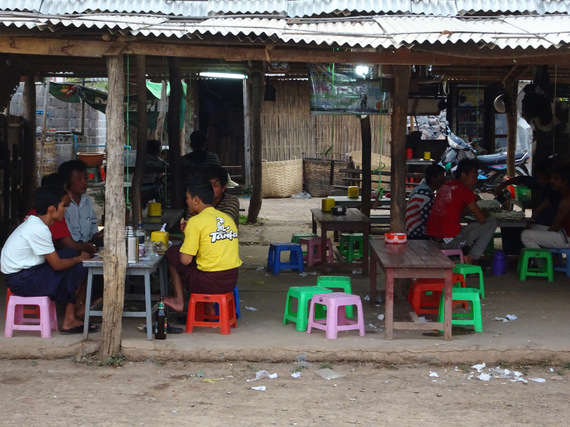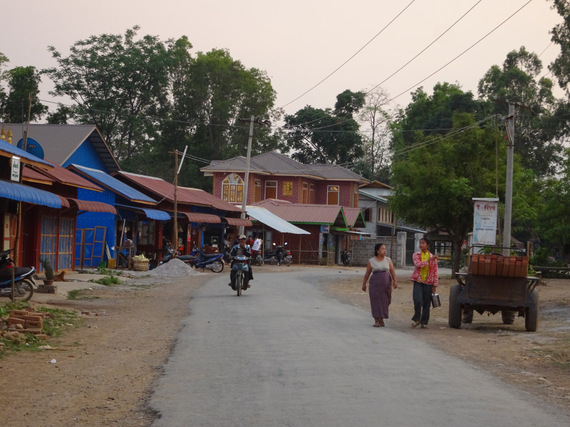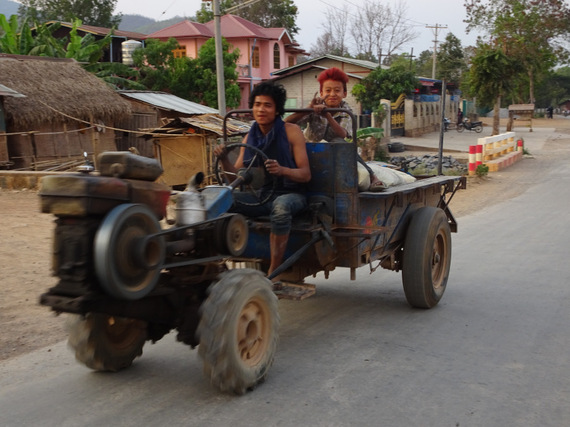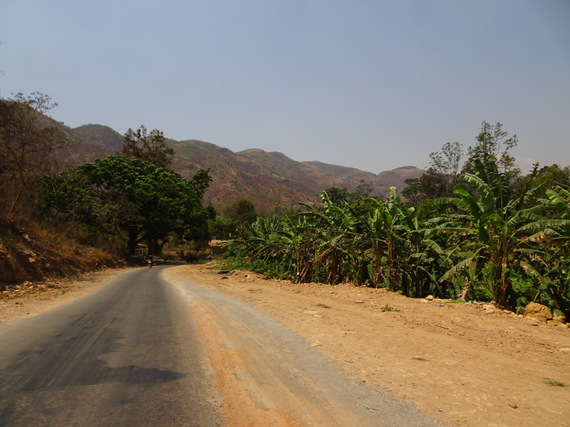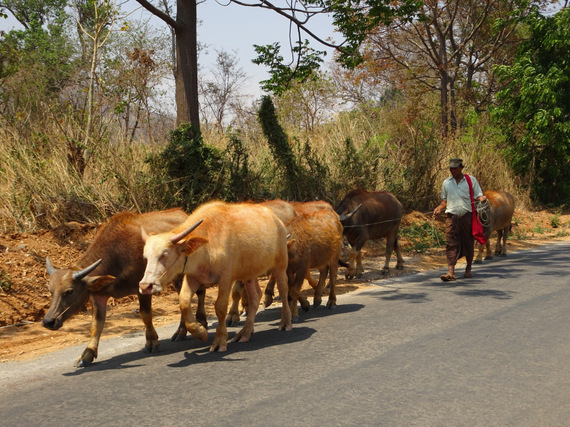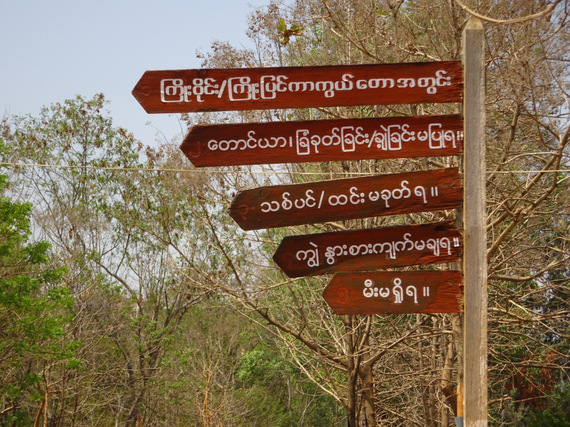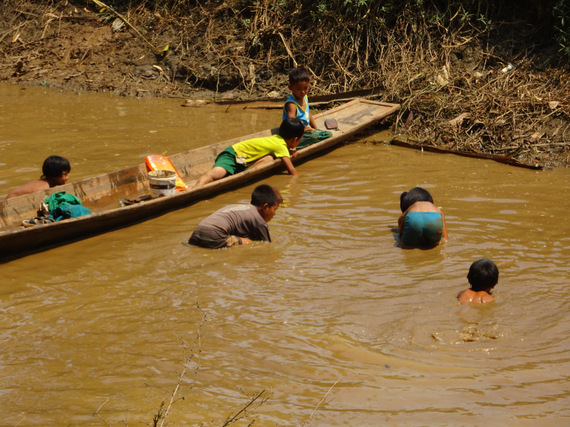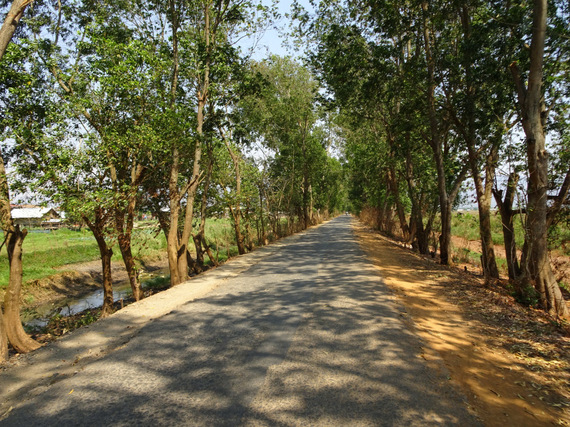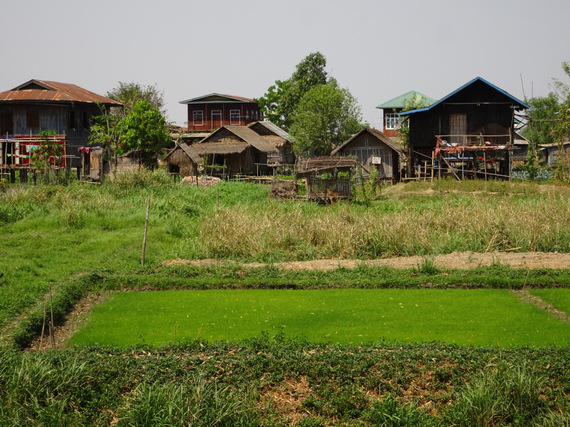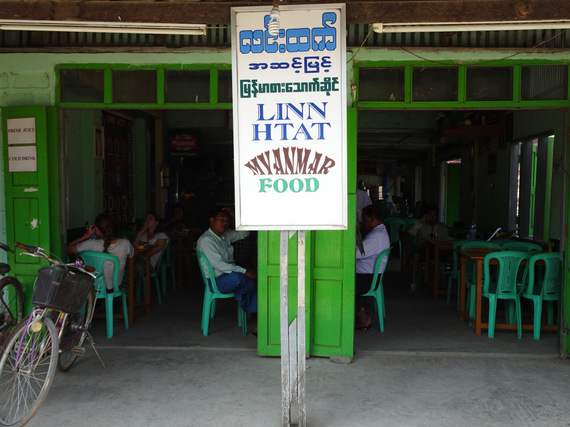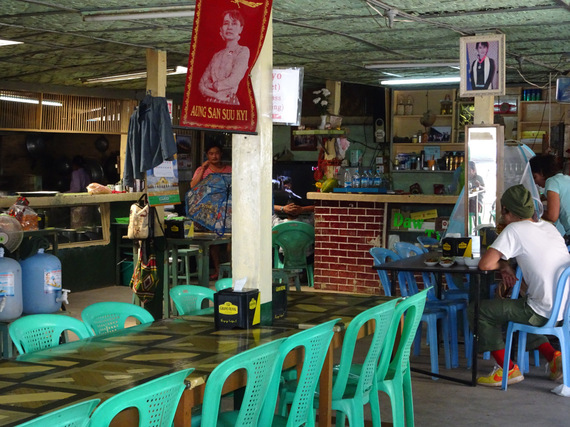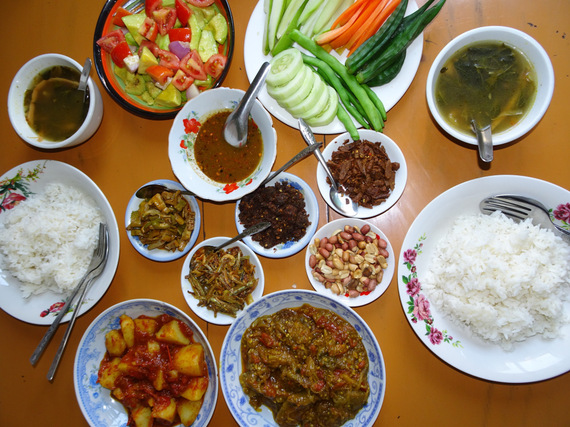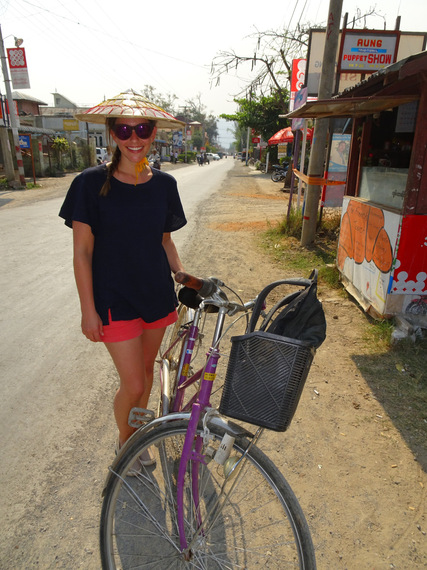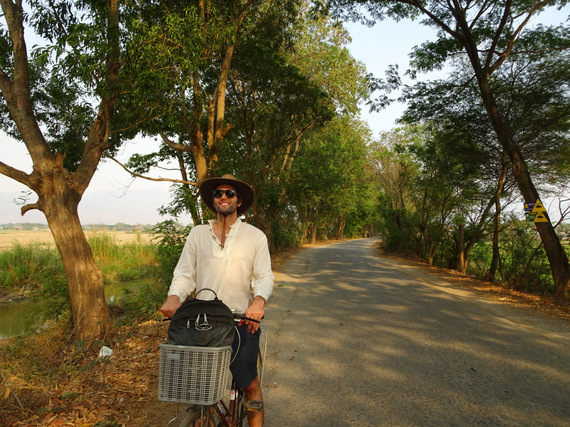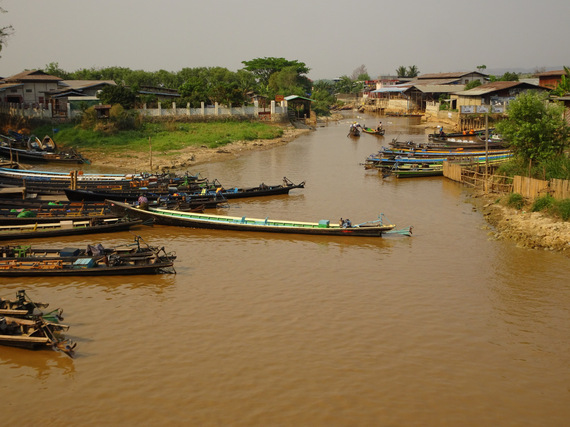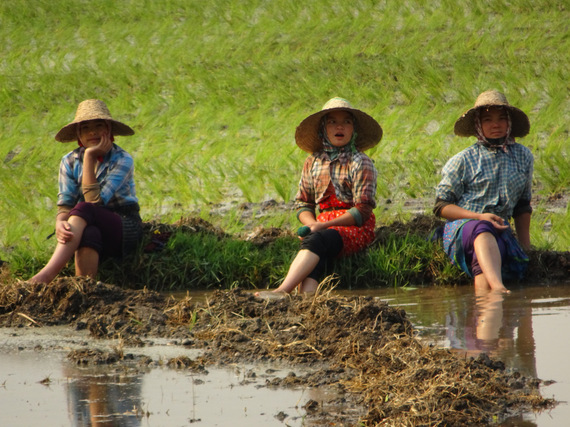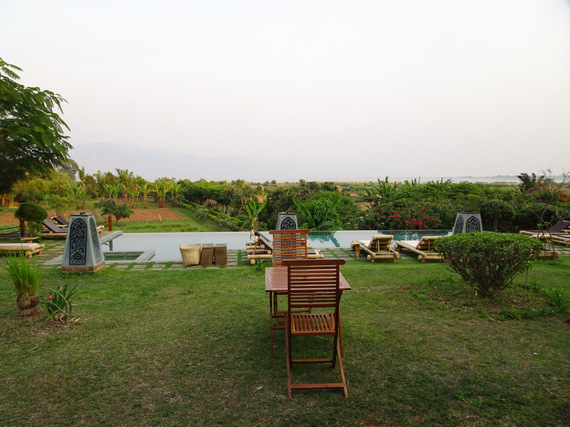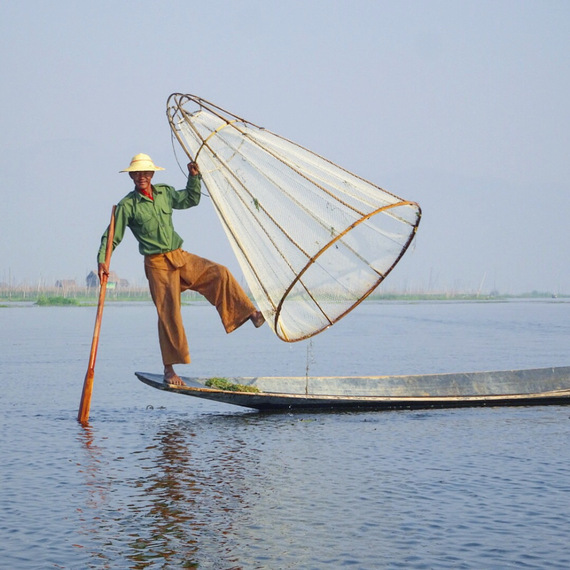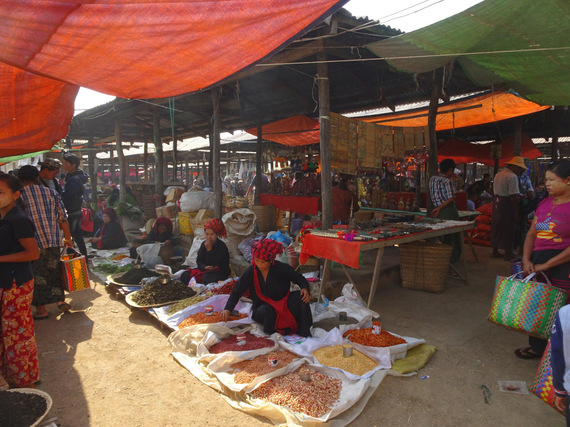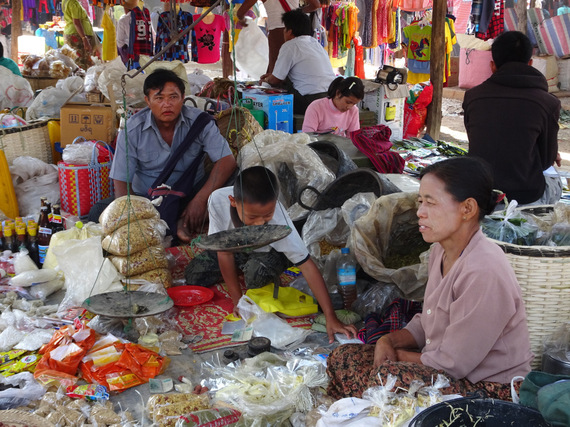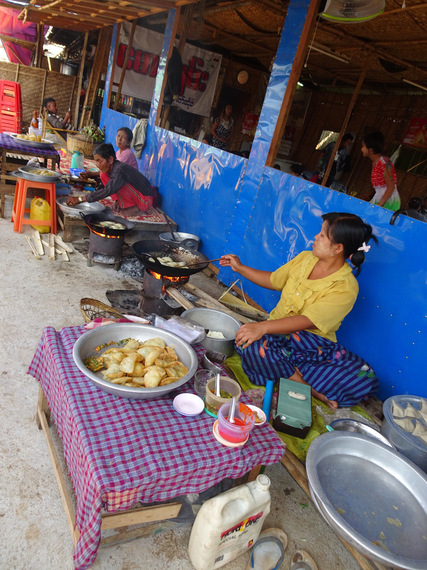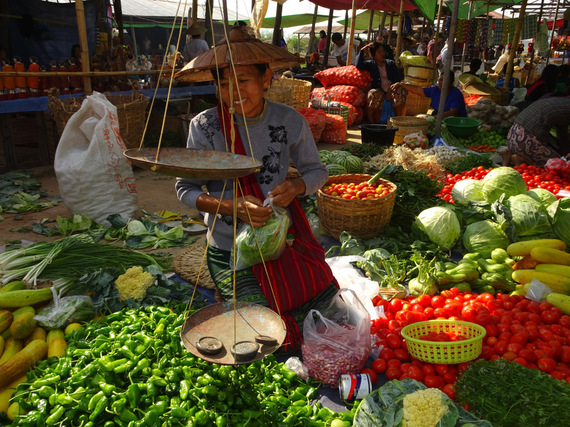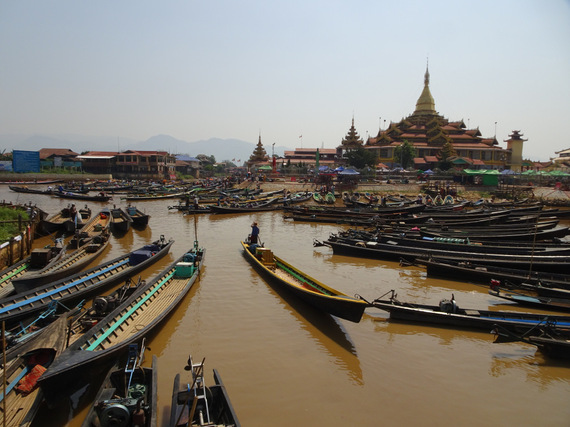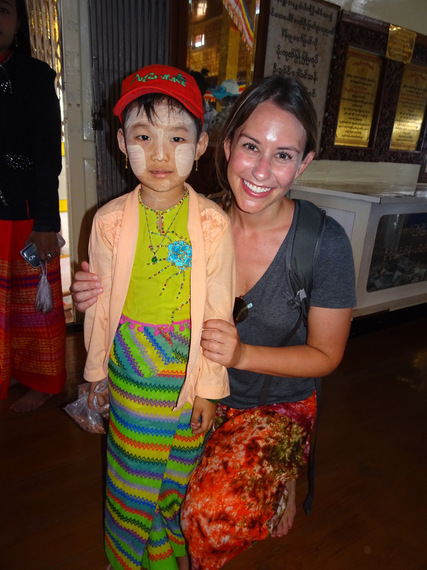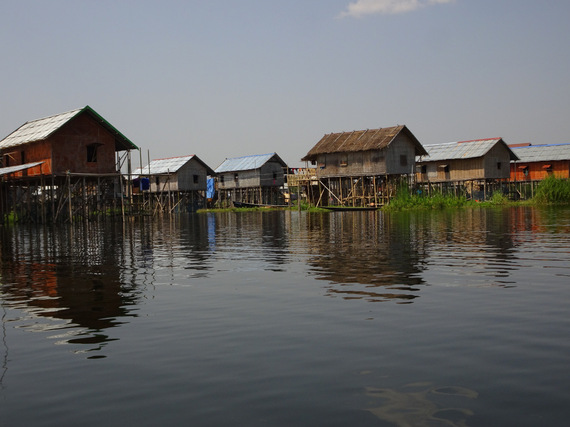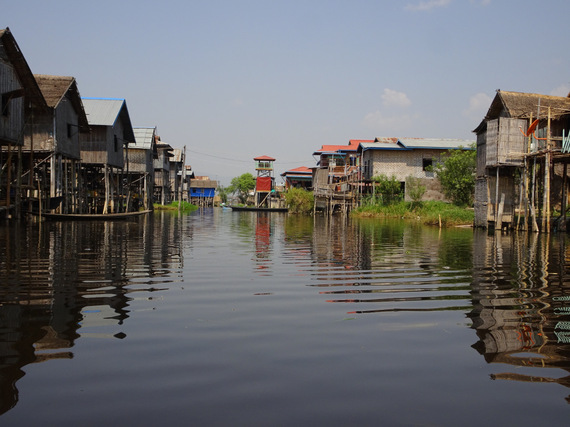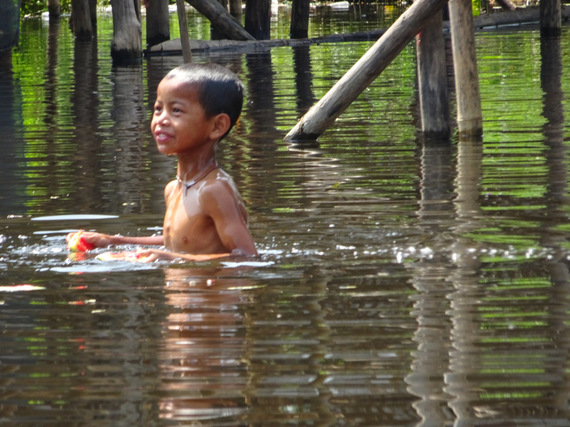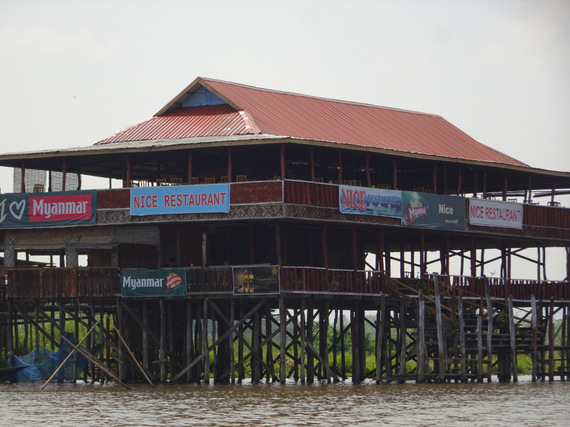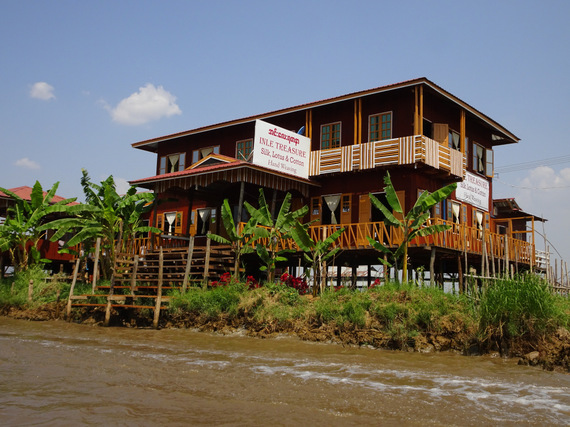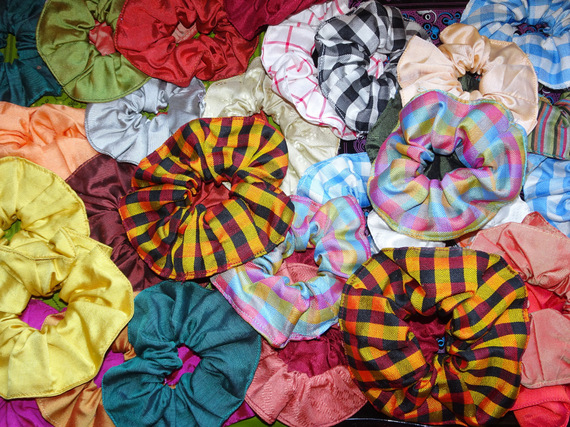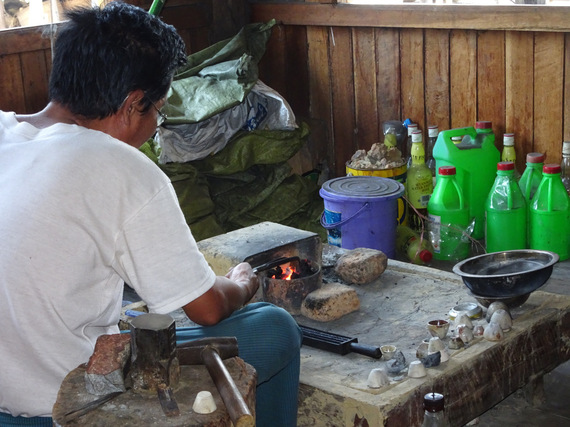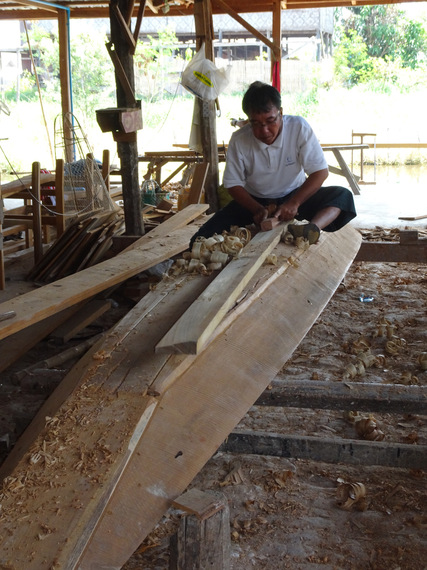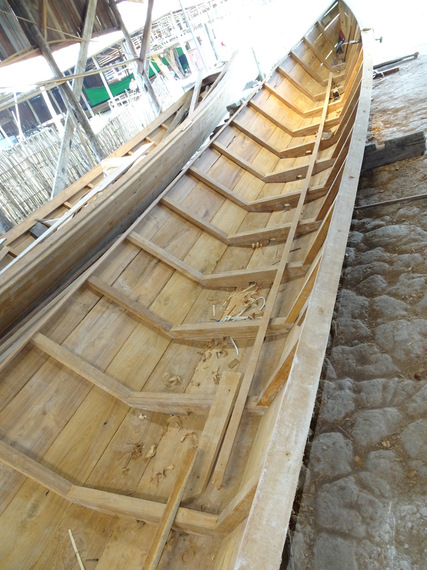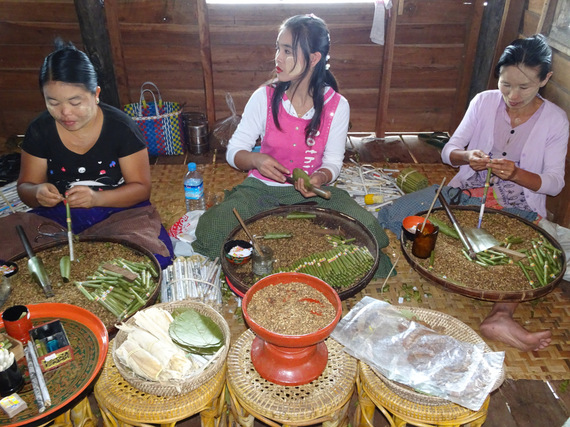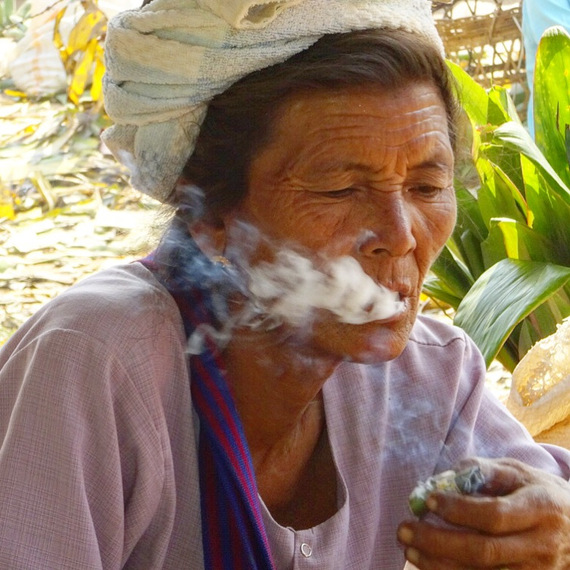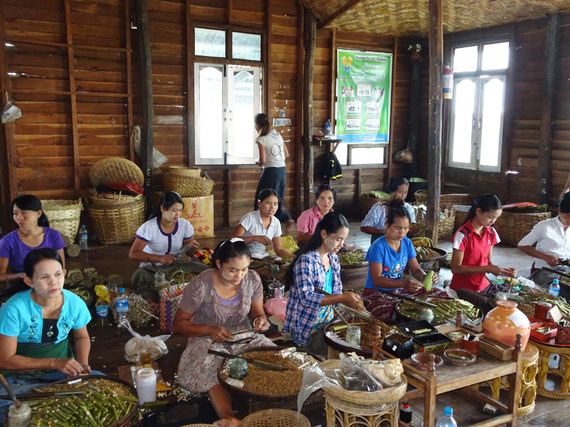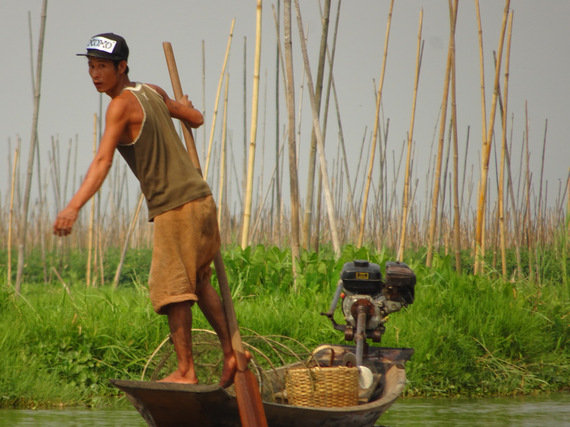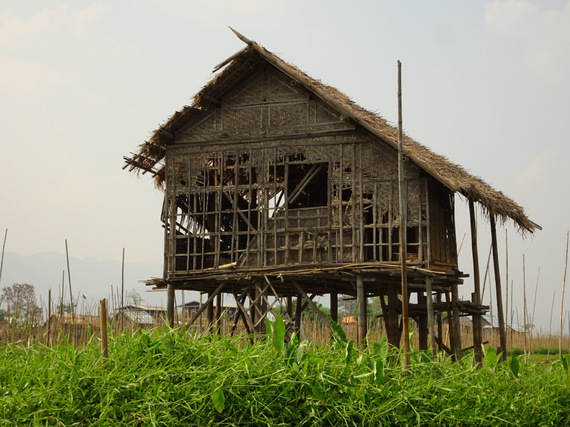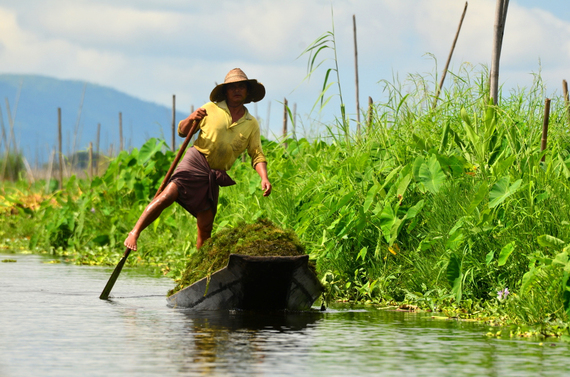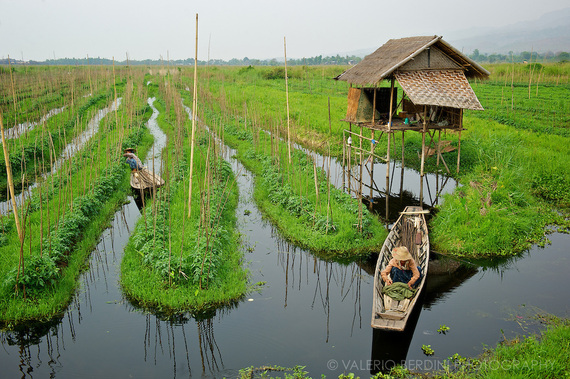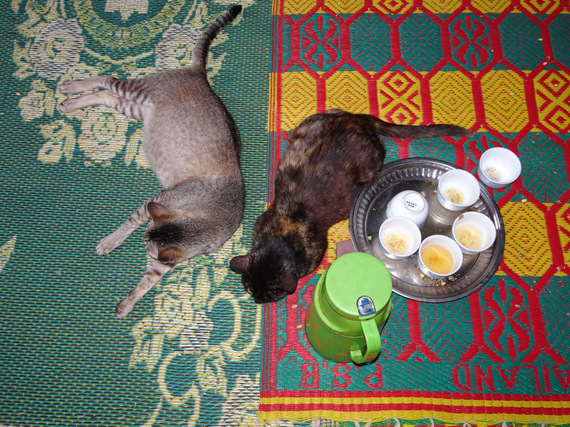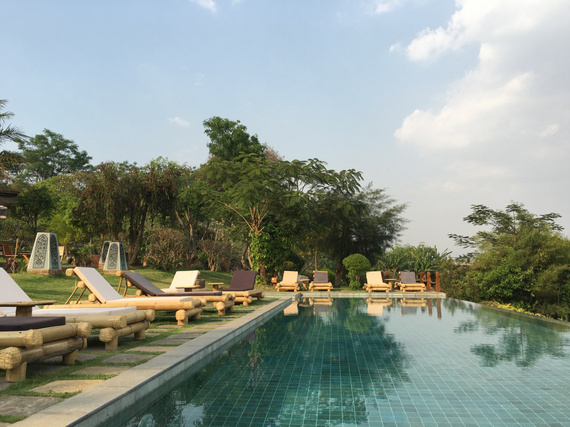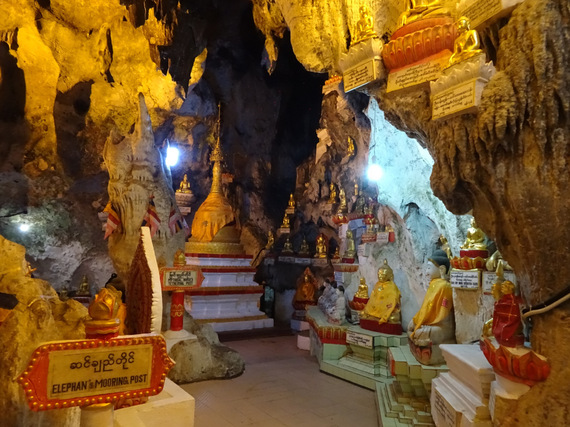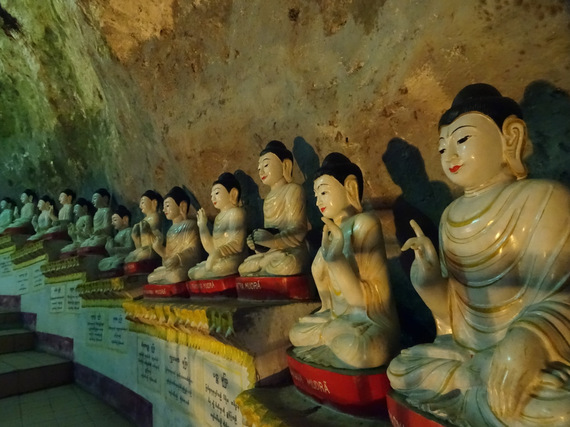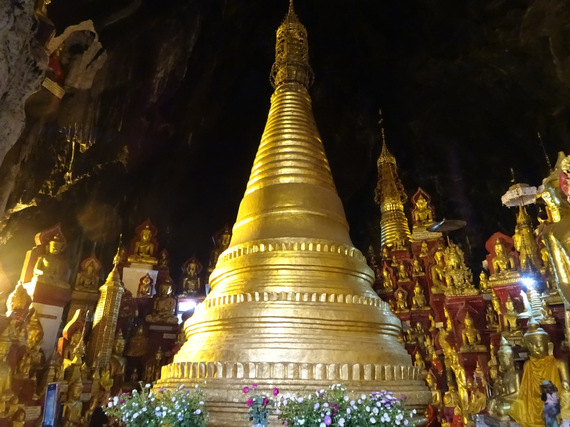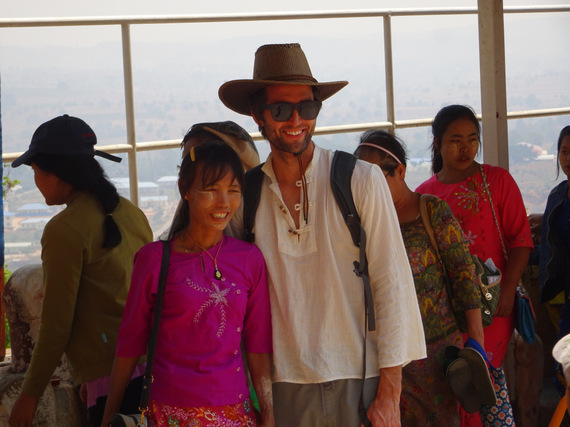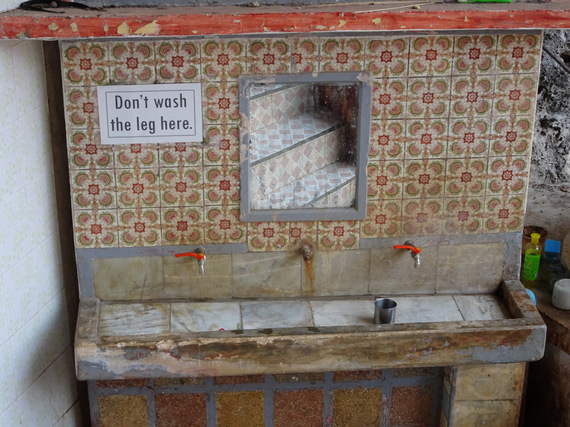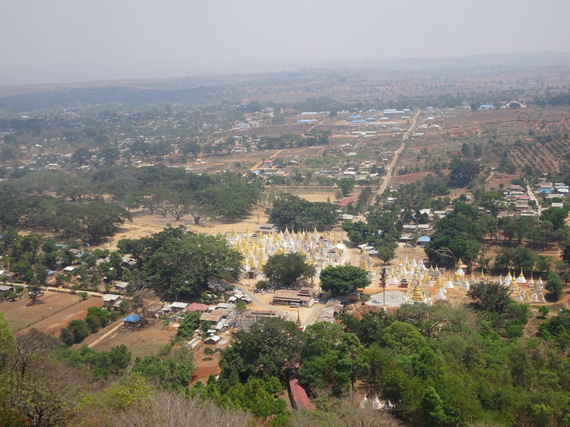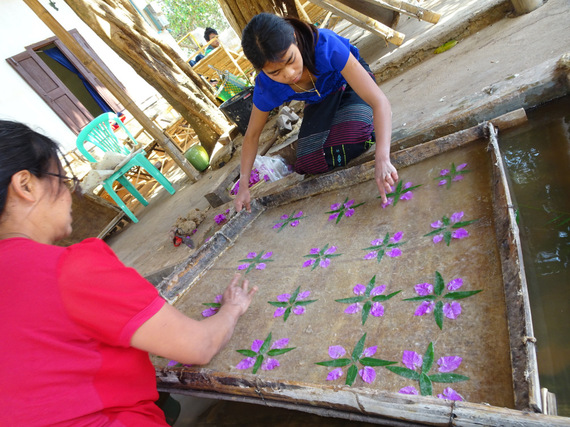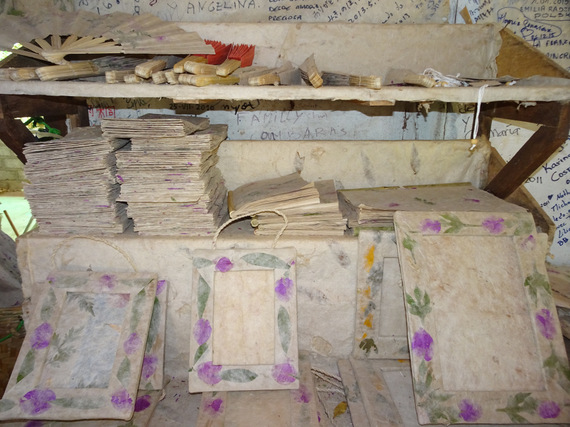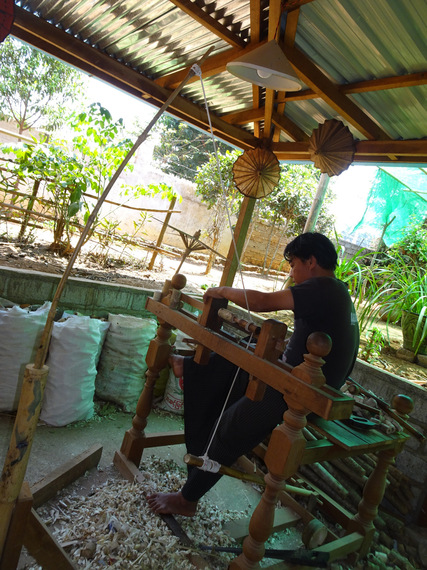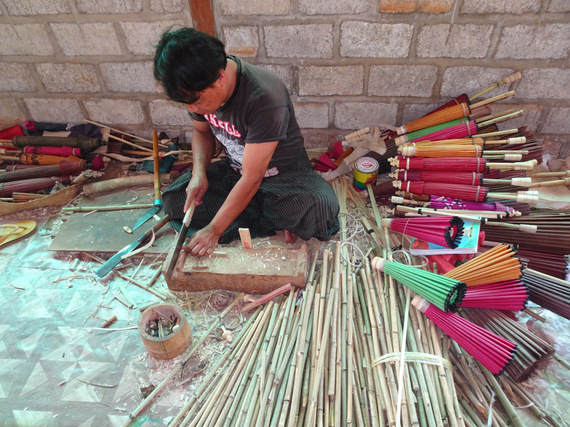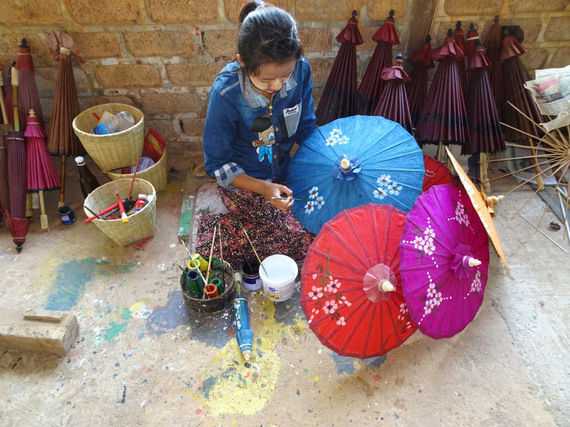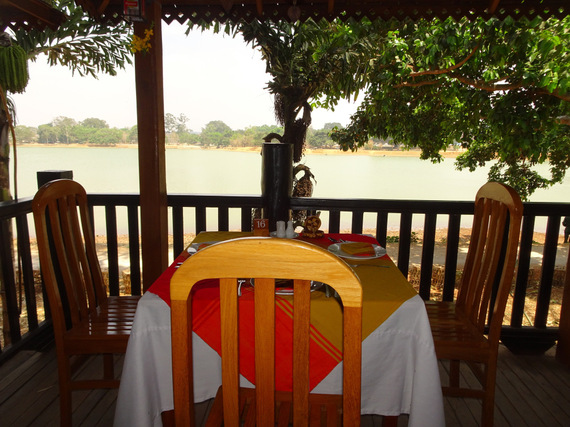On Thursday, March 31st, we arrived in the town of Nyaung Shwe (located in the Shan State of Myanmar) around 4pm after a 7.5 hour bus ride from Bagan on JJ Express. Once we got to the bus station, it was another 25 minutes until we reached our hotel for the next four nights, Inle Lake View Resort & Spa. Sounds luxurious, huh? We definitely splurged a little on this city ($120 a night). Since Inle Lake is such a small, remote, quiet town, we figured it was well worth it. And there didn't seem to be any "average" priced hotels. It was either backpacker hostels or 4-5 star resorts. We chose the latter, which did not disappoint. The grounds were gorgeous. Very tranquil. And, we were upgraded for free to a suite. Jackpot!
Once we unpacked, settled in and checked out the various areas of our hotel (pool, restaurant, bar, spa, etc.), we took a casual stroll around Kaung Daing, the tiny little village we were staying in. Not a whole lot happening here, which kind of made it so awesome. This is what life in a small town is like. No tall buildings, no traffic lights, no hustle and bustle. While out and about, we saw a few good men having happy hour on the same child like plastic chairs Yangon and Bagan seemed to have as well...
Simple yet adorable...
A different mode of transportation than what we are used to...
A pick up game of foot volley...
When I say there is nothing really near us, I truly mean it. Everything seems to close around 6pm and the only restaurants to eat at are back in Nyaung Shwe, which is a twenty five minute car ride away and taxis don't exist here. We are literally stranded but that's not always a bad thing. Luckily our hotel's restaurant was super nice, with a great variety of food options so we just had dinner here and enjoyed a low key evening.
Day 2 - April 1st
Happy April Fools Day! One of my favorite holidays but I feel as though my friends and family almost expect me to play a trick so sometimes I need to take a year off. That way I can then fool them the next time. Oh how I love playing games with people. Life is too short to take seriously.
Today we went on a 5 hour, 16 mile bike ride through the Khaung Daing village, which was very rural, to Nyaung Shwe and back. I felt like Lance Armstrong but the only performance enhancing substance I was feeding off of was the pure determination to make it back in one piece. No scrapped knees, no ripped pants, no flat tire. Is it really that hard, Kim?
We rode past a man walking his buffalo...
Which direction would you choose?
We saw young kids playing in not so clean water. But hey, whatever floats your boat (literally)...
Beautiful, shady, tree filled roads...
Houses all on stilts...
When we finally made it to the town of Nyuang Shwe, we grabbed a bite to eat at Linn Htet, which served traditional Myanmar/Burmese food (I never know which name to use). It is a family owned restaurant and even their eight(ish) year old son worked there. Starting them young I guess. What's that you say? You want to know what we ordered? Well, I hope this doesn't make you hungry because it was a TON of food. And surprisingly quite delicious as well. The main dishes were potato curry and eggplant curry but each came with a wide variety of sides including soup, fried peanuts (Dad, you would have LOVED these!), fried baby dried fish (definitely did not eat them), fried soya beans, fish paste sauce and seasonal vegetables - all for 3000 kyats ($2.50) each. Talk about a bargain and I didn't even have to whip out my negotiation skills.
Along the way, Vinny and I both bought hats because the sun was shining real bright and real strong. That's me below. Don't I look like a local? Vinny kind of looks like a cuter version of Indian Jones, haha.
Let's see how many people we can fit on top of our truck...
"Oh when the Monks, go marching in. When the Monks go marching in. O Buddha, I want to be in that number. When the Monks go marching in." Yes, I revised the lyrics.
Row, row, row your boat...
Coffee break...
When we got back to our hotel around 5pm, we were drenched in sweat and extremely exhausted from the heat as well as the exercise so we headed straight to the pool. Do not pass go, do not collect $200. Pure magic what some cold water can do to you sometimes.
Day 3 - April 2nd
This morning we woke up at 6am, had breakfast at 6:45am and then departed for a full day boat tour on Inle Lake at 7:30am.
Say hello to one of the many infamous fishermen of Inle Lake. They have a very unique technique that involves standing on one leg while rowing with the other leg, allowing both hands to be free for catching fish. Talk about a true balancing act. Quite impressive.
Our first stop of the day was the "5 Day Market", which rotates between 5 different locations over a 5 day period. Creative name, huh? Let me put this market in American terminology. It was a Bed, Bath & Beyond meets Target meets Walgreens meets Farmers Market meets Best Buy meets Kay Jewelers meets Whole Foods meets Blockbuster (when they still existed of course) meets 99 Cent Store meets Swap Meet meets Payless meets your local mall's food court. Anything and everything you could ever need was here. One stop shopping. Come one, come all.
Next up was Phaung Daw Oo Pagoda, which is the most highly revered monastery in the Inle Lake area. The pagoda houses five small gilded images of Buddha believed to have been brought to the area in the 12th century. They are covered in gold leaf to the point that their original forms cannot be seen. Like other pagodas, only men can approach the inner areas. Gender equality is such a norm these day that it's a little awkward when the women are forced to stay back and the men are allowed to go up. I took at least 20 photos with random locals at this pagoda. My mouth was quite tired afterwards from smiling. I felt like I just finished five packs of Big League chewing gum. Hopefully TMZ doesn't get ahold of those images, I'm sure they would be worth a lot.
Here are a few photos of what life on Inle Lake looks like. The only way to get to these houses or restaurants or shops is by boat. Pretty unique living.
After the pagoda, we visited the Inn Paw Khon Village, where almost all the people in this area are related to weaving work of some kind or another including silk, lotus, cotton, hue coloration, design and production. I learned something new today. There is only one place in the world where the fibers of the lotus plant are woven into scarves and shawls. It is a form of weaving that is entirely unique to Myanmar (Burma) and specifically to Inle Lake. And the fibers of the lotus flower costs 7x more than silk because it's so rare and considered holy. Now if that is a question on Jeopardy, just don't forget where you heard it first. We walked through a tiny workshop where women sat at their machines and created beautiful objects such as scarves, dresses, pants and scrunchies. Yes, scrunchies. Blast from the past. Some of the scarves were selling for $250 USD - ouch!
Ywama village, one of the few craft villages, is famous for its goldsmith and silversmith.
Men working hard while building wooden boats starting only with a tree trunk and a saw...
A cheroot is a cigar special to Myanmar (Burma), so distinctive in fact that they have been nicknamed a "Burmese facial feature." The world "cheroot" is derived from the French word cheroute, which comes from a Tamil word meaning "roll of tobacco." The cheroot has both ends clipped and is made with a blend of tobacco and fragrant wood chips, then rolled up with the dried and flattened "tha nat phet" leaf. A filter is added made of dry corn husks or sugar cane fibers for a stronger smoke. It is not unusual to see Burmese ladies puffing away on these cheroots in the morning, afternoon and/or evening.
The women of Inle Lake are famous for hand-rolling the cheroots very quickly. Some can roll over 500 cheroots a day. We sat and watched about 16 women perform this act live and in person. They can do it with their eyes closed if they had to. Pretty incredible.
Following the talented and hand savvy cigar rolling ladies, we hopped back in our boat and rode past the Floating Gardens, where locals grow vegetables and fruit (tomatoes, eggplants, chilies, flowers, etc.) that float on the surface of the lake. The floating garden beds are formed by extensive manual labor. The farmers gather up lake-bottom weeds from the deeper parts of the lake, bring them back in boats and make them into floating beds in their garden areas, anchored by bamboo poles. These gardens rise and fall with changes in the water level, and so are resistant to flooding. The constant availability of nutrient-laden water results in these gardens being incredibly fertile. Rice cultivation is also significant. Producing these items all year round is what allows the Shan State of Inle Lake to be called "The Garden of Myanmar".
Last on our spectacular day tour of Inle Lake was Nge Phe Chaung Monastery, otherwise known as "Jumping Cat Monastery". This nickname came from the idea that cats were trained to jump through hoops but when the head monk died, so did most of the cats. The new head monk didn't think it was proper to have cats entertain tourists in that fashion so they are very limited today - which was totally fine with me because I don't really get along with them. They make me sneeze, itch and have trouble breathing. Not a pleasant experience. However, the monastery itself was a beautiful wooden building built on stilts around 200 years ago and is considered the oldest and largest monastery in the Inle Lake region. Inside, there was an impressive collection of Buddha images respectively in Shan, Tibetan, Bagan and Inwa style.
For the rest of the day, we gladly hung by the pool, watched the sunset, listened to nature and enjoyed yet another delicious dinner at the hotel's restaurant. What an awesome day!
Day 4 - April 3rd
Our day started with a two hour drive out to Pindaya, which is famous for its limestone caves, its attractive lakeside setting, and the traditional Shan paper umbrellas that are manufactured here. Set deep in the hillsides, the caves (some of which serve as meditation chambers) contain some 8000 Buddhas of various sizes, which are made of white marble, bronze or plaster, and coated with gold leaf. New ones are constantly being added as people continuously donate them from all over the world. It's a very rare site to see and was a great way to escape the heat.
Uh oh, should I be worried?
Good thing they have this sign because I was just about to wash my leg there...
Great views of the city from high on top of the hillside...
After we explored the caves, we visited a family-run business (4 generations so far) that makes the famous Shan paper. Stemming from the fiber of the mulberry tree, very wide-spread shrub in the mountains of the region, this paper is very well-known in Myanmar. The manufacturing process is rather long. During a day, the fibers of the mulberry tree are dipped into the water then get plastered in the wood fire during more than 5 hours with a mixture of wood ash or clay. The paper dough, displayed on top of a trunk wood piece, is then beaten with a wooden mallet for several minutes. Later, a bamboo frame covered with a very fine cotton fabric is settled at the bottom of a tank filled with water. With their hands, the pulp of paper is diluted in the water and then distributed in a equal way on the canvas. After having removed air bubbles and lumps of paper, the frame is pulled out from the water tank, while the pulp of paper stays on the cotton canvas. The frame and the pulp of paper will dry for hours in the sun and finally the pulp will be transformed into a paper sheet. Delicately, the sheet will be removed from the bamboo frame.
This was extremely neat to watch. The mom and daughter here are working together as a team, hand in hand. They are diligently creating beautiful designs on the Shan paper that will eventually be turned into umbrellas, fans, paper, envelopes, photo frames, lamp shades, etc. They make about 20 of these a day. A very detailed oriented line of work, one that requires hand/eye coordination and patience. Something I would not succeed at.
In addition to the Shan paper, the famous Burmese parasols are made here as well. They are completely done, step by step, by hand starting from the bamboo handle and the pawl, which allows the parasol to stay opened, to the umbrella frame on which the paper sheets will be stuck to the artwork that is painted on the final product.
Our wonderful day trip ended with lunch at Green Tea Restaurant...
We got back to the hotel around 5:30pm, chilled at the pool and chatted it up with the General Manager, Eric, who is from France. Throughout our travels, we've certainly noticed a pretty significant difference between Western hospitality and Eastern hospitality and from the moment we entered this hotel, we could tell it was run by a Westerner. And that's a good thing (in my biased opinion at least).
Day 5 - April 4th
Although we loved Inle Lake, we had way too much time here. Three nights is plenty. Not only did we have four nights but we also had four full days because we are taking another overnight bus tonight, which doesn't depart until 10pm. Luckily, Eric let us keep our room all day at no extra charge. This was a HUGE help. We didn't really do much though, which was actually nice. However, it wasn't as quiet as I would have hoped given we were in the middle of nowhere. This unexpected noise was due to the large population of cicadas. Have you heard of these? I sure hadn't but now that I've done research, it all makes sense why I was about to pull my hair out. Here are few random facts on cicadas just in case you were as interested as I was.
Cicada comes from the Latin word meaning "tree cricket"
Cicadas are among the loudest insects known to man, and a swarm of them can produce sounds up to 120 decibels. That's louder than a rock concert (about 115 decibels), and comparable to the noise from a chainsaw (humans start to experience pain from sound at the 110 to 120 decibel level).
Only male cicadas sing. They do this in an attempt to find a mate.
Different species have different songs to attract only their own kind.
Adult cicadas have short lives, usually only a few weeks.
Most of their lives are spent as nymphs underground. For some species this can be up to several years.
Cicadas feed only on plant sap using their piercing, sucking mouthparts.
Birds, bats, spiders, wasps, ants and mantids all prey on cicadas.
Tonight we are headed to Mandalay. As we were sitting at the bus station, I started talking with some random folks because hey, why not. Sometimes I need more than just Vinny. One girl was from Germany and the other guy was from China. I just love meeting people from all over the world, learning about where they come from and where they are headed (geographically not figuratively).
As we boarded the bus, we were quite impressed yet again with JJ Express. Leather reclining seats, personal TV's, blankets, pillows, air conditioning - not bad for $12 per person. This is going to be an easy, breezy 9 hour ride. That was, until the monk behind us started snoring as if every breath he took was going to be his last. Oh geez, this is will be a super duper long night after all
Leave a Reply
